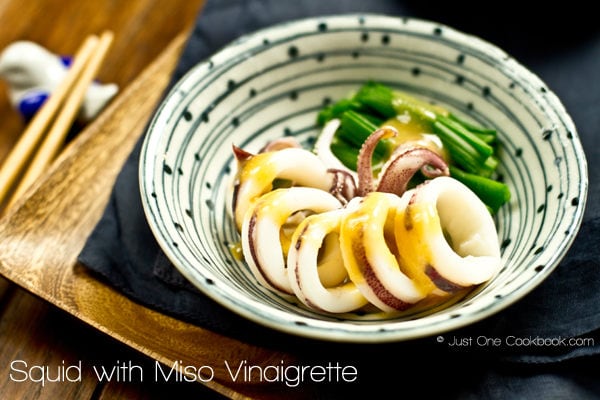
My 6-year-old son finished a 4-week swim camp last week and the teacher said he’s ready for a more advanced class when he finished! We didn’t sign up for more swim camp though, and he starts science camp tomorrow. It’ll be the first time for him to eat lunch at school because his kindergarten was half day. I am looking forward to making lunch for him to bring.

However, to be completely honest I am a bit nervous if I can wake up early enough to prepare his lunch, not sure exactly what to pack, and worried if he’s going to eat everything I pack in a short lunch break… I’m just a worry bug.
I’m planning to pack Japanese bento for a couple of days a week and sandwiches in between. He had been enjoying nice warm lunch every day till now so hopefully, he’ll be able to adjust to lukewarm or cold lunch. Although it’ll be fun for him to eat lunch with his friends, I’ll miss our lunchtime… well at least I still have my daughter to eat lunch with me. Anyway, let’s move on as I will have to go sleep right after writing this, so I can wake up early to prepare! My husband thinks I am really silly – instead of worrying about whether he’ll understand the subjects being discussed at camp, I am worried about his lunch!
Now today’s recipe. Japanese loves seafood and it seems like we eat almost everything from the ocean. One of the more common seafood ingredients we enjoy is squid. Squids are served in many ways, as sashimi, and on sushi, deep-fried, baked, grilled, and even sold dried as a snack. Although squids seem less popular in the US, besides deep-fried calamari, they have great health benefits. They are low in fat and calorie and high in protein, and they also reduce cholesterol in the blood.
Maybe fresh squids look too intimidating for you to prepare and cook? Well, focus on the end product and hopefully, you won’t mind. 🙂 One of the more popular squids is Spear squid, we call it Yari Ika in Japanese, and the meat tastes sweet and it’s soft and super delicious. The dish I am sharing today can be served as an appetizer or side dish, and it goes well with alcoholic drinks.
The sauce I used to compliment squid is Miso vinaigrette, which is sweet and tart from mirin and rice vinegar. The miso flavor provides a nice body to the vinaigrette. If you are not a fan of squid, you can simply use this miso vinaigrette for blanched vegetables, sashimi, shabu shabu pork, etc. Hope you will give it a try!
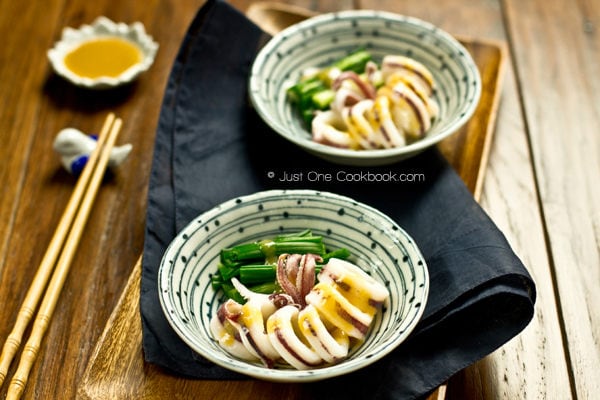
Wish to learn more about Japanese cooking? Sign up for our free newsletter to receive cooking tips & recipe updates! And stay in touch with me on Facebook, Pinterest, YouTube, and Instagram.
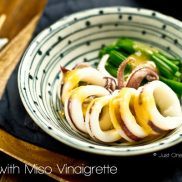
Boiled Squid with Miso Vinaigrette
Ingredients
- 2 spear squid (fresh; yari ika in Japanese)
- 3 green onions/scallions
- Diamond Crystal kosher salt
Miso Vinaigrette (Sumiso Sauce):
- 2 Tbsp miso (I used white miso)
- 2 Tbsp rice vinegar (unseasoned)
- 2 Tbsp sugar
- ½ tsp mirin
- Japanese karashi hot mustard (optional)
Instructions
- Gently pull the head and tentacle from the body and set aside. With the back of the knife press out the insides and discard. Clean the squid thoroughly under running water.
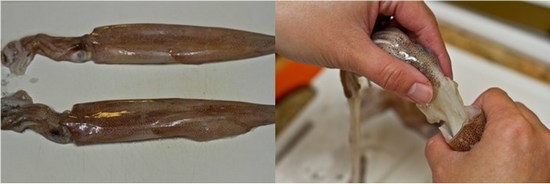
- Remove the quill (the clear sword shaped cartilage) from the squid. Insert your finger to remove any bits that might be left inside.
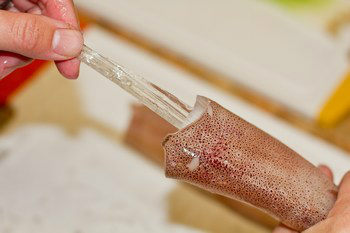
- If you prefer, take off the outer skin by peeling it. I kept it on today so that after boiling it gives nice red color. Also, removing fin is optional.
- Cut off tentacles just above the eyes. The tentacles have a tiny piece of cartilage which is the beak and you can cut off the beak with scissors or knife.
- Then cut the body to rings and cut tentacles into small pieces.
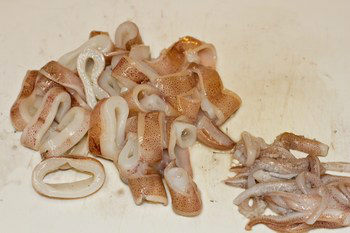
- Cook the squid in boiling water until it becomes completely white. Soak in iced water to cool it down.

- Boil water in a small saucepan. When boiling, add salt and soak the white part of the green onions in the boiling water for 10 seconds. This way the thick part will cook longer than green tender part. Bend the green parts and boil for a few seconds. Take the green onion out and let it cool down, cut into 2 inch pieces.

- Combine the vinaigrette ingredients and mix well.
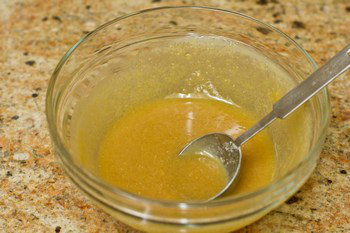
To Serve
- Serve the squid cold or at room temperature and pour the vinaigrette on the squid right before you serve.
To Store
- Keep the leftovers in an airtight container and store in the refrigerator for 1-2 days.

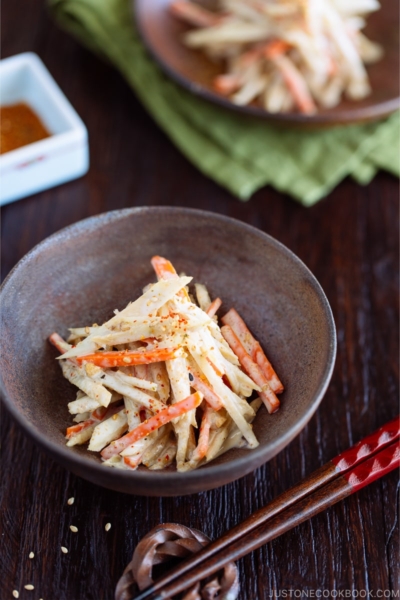
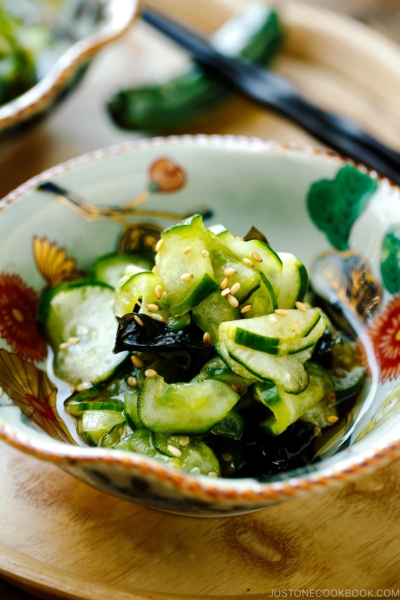
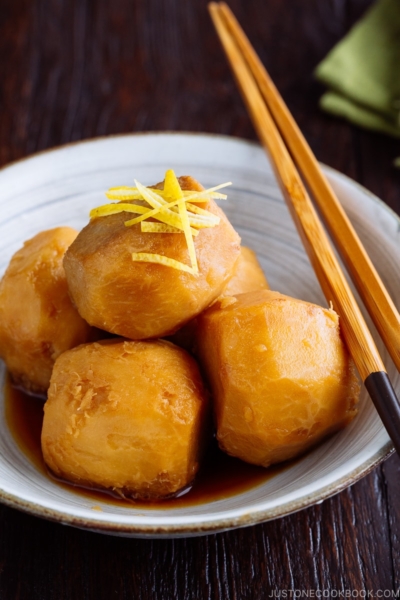




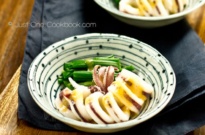
Hi, Nami! I love squid, but I’ve never thought about making squid on my own because I think actually cutting the squid and everything is kind of intimidating. But, I know there’s precut squid in the supermarket. Could I use that instead?
Hi Ashlynn! You can use precut squid. 🙂
Hi, Nami! This looks delicious! I bought a large whole squid the other day. The tube was just shy of 12 inches! Add the tentacles to that… I’ve found that these larger squid are often best treated like octopus. Normally I cook the the smaller squid (4-5″ tubes) quickly. The big ones have lots of deliciousness in their tubes, which I don’t discard, such as the digestive gland and reproductive organs. So I braised this squid whole, in a savory mixture of daikon, ginger, soy sauce, vinegar, hot peppers, and other seasonings. Cooked it for about an hour. It was perfect. Not rubbery but firm. Not over-cooked. The best thing is I ended up with a beautiful squid stock that had oils from the the squid innards floating on top…a beautiful red, looking like a chili oil. That was from the digestive gland. I need to stock my freezer with these. They are so easy to prep and taste wonderful.
It sounds so delicious, Chieko!!!! I’m jealous now… Thank you for sharing your story and tip! 12 inches!!!! 😀
Hi Nami,
Thanks for this recipe! It looks great.
For the cooking time of the squid, I heard it should either be very short or very long to get something tender. How much time did you cook it?
Thanks, have a nice week!
Bastien
Hi Bastien! It should take about 1-1.5 minutes, depending on your heat and how thick is the cut. Hope this helps! 🙂
Hi, Nami. I only have Saikyo miso in my fridge. Will this be too sweet for the dish?
Hi Elaine! It might be too sweet, but it has unique flavor, so it could work if you tweak a little bit. 🙂
You totally rock! You awakened the little Japanese boy in me. I’m 42 now but this very receipe, and subsequent dish instantly took me back to the shores of Hokkaido before my family moved to the States. Thank you for sharing the receipe and the step by step instructions. You gave me a chance to share some soul food with my kids who have just enough japanese in them to love this yummy dish!
Hi Koji! Thank you so much for your kind feedback! I’m so happy you liked this recipe! It’s so simple yet very delicious bribing out nice flavor of squid. 🙂 So happy to hear that this reminded you of your home!
Just made this on a warm bed of rice as a main. Absolutely amazing!
Hi Scott! Thank you so much for writing your feedback. So happy you enjoyed this recipe! You made my day! 🙂
Hi Nami!
I’m a big fan! 🙂 I have just one question about this recipe…I was wondering if you need to use shiro miso, or can you use a different type of miso like koshi miso?
Hi Ceres93! Thank you so much for your kind words! 🙂 “Koshi” is not a kind of miso, so I assume it says “Aka (red)” koshi miso etc.
For this particular recipe, I recommend shiro or awase miso, but not aka miso. Hope this helps. 🙂